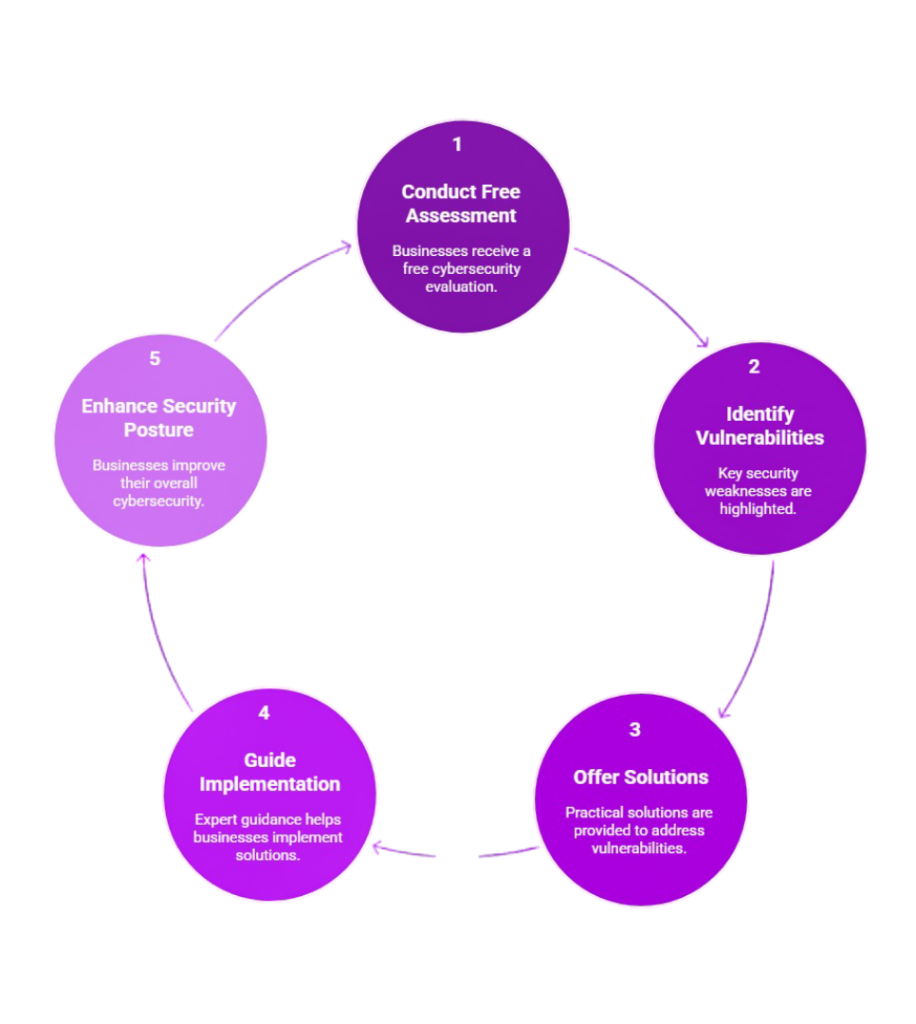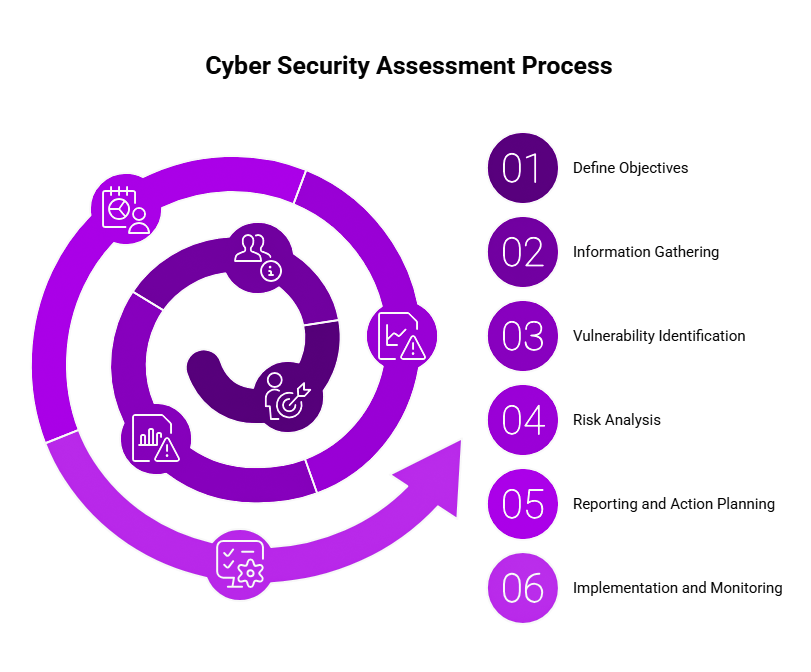
Cyber security assessment is comprised of a comprehensive analysis of your IT environment to establish your vulnerabilities, assess your risks and determine your general preparedness to cyber threats. Such evaluations give companies a clear picture of their present security positions and which areas they should improve. A cyber security assessment, unlike a regular check-up, delves into your IT infrastructure, policies and practices such that when a check-up is conducted, it is thorough.
All organizations, both small and large, can be targets of cyberattacks. A cybersecurity assessment can enable you to find the gaps before malefactors penetrate. Lack of frequent reviews leaves businesses at risk of blind-side weaknesses. Moreover, evaluation supports the industry’s best requirements and regulatory compliance, which decreases the risk of monetary immediate income, lawsuits, and career-ending reputations.
Unlike traditional assessments which concentrate on vulnerability identification, a cyber resilience assessment determines how your organization can respond, adapt to the situation, and speedily recover after a cyberattack. Cyber resilience is more than just prevention; it also guarantees continuity, minimal impact, and quick recovery of services after incidents happen. Organizations that do not forgo cyber resilience are not afraid of threats because they are confident to tackle any threat and recover in the shortest time.
Performing a comprehensive IT security assessment involves clearly defined steps. First, identify the scope and objectives of the assessment, outlining which aspect of your IT environment you are going to examine. Then, collect information by reading over your security laws, network, and working practices. Initiate your IT and security team in order to analyze and discover present safeguards and breaches.
Compare the security practices that are in place in your company with industry best practices, standards, and industry requirements. Once you have written down your findings, you should prepare an action plan that defines the steps that are necessary to overcome the weaknesses that you discovered. Lastly, keep a record of your improvement to sustain it and face new threats by checking your results regularly.

A detailed cyber security audit investigates a number of key aspects of your company. This comprises the assessment of your endpoints, networks, and servers. It examines access control by users, data encryption, firewalls, and software updates.
Assessments also examine your policies around incident response, employee cybersecurity awareness, and compliance with regulatory standards. In short, they offer a comprehensive look into your entire cybersecurity ecosystem.
Frequent evaluations are beneficial to businesses, large or small. Comprehensive and continuous assessments may be performed in large enterprises as they have more complicated IT infrastructures and an increased exposure to risk. Frequent assessments are also required by small businesses and medium businesses, but they may deploy free cybersecurity assessments first to get a clear picture of their security baseline. Assessments enable all businesses to have powerful safeguards and healthy cyber resiliency, no matter the size.

At Hoploninfosec, we believe every organization deserves strong cybersecurity, regardless of its budget. This is the reason why we provide a free assessment of cyber security to businesses that require to know their security posture without parting with their money instantly.
This diagnostic test shows the most serious areas of vulnerability, areas of severe threats, and offers concise, workable solutions to start enhancing your security. Although it cannot be used in lieu of a comprehensive assessment, it provides small and growing businesses with the needed information on their future course of action.
We are aiming to popularize cybersecurity. Hoploninfosec is not just a report, but the foundation of long-term protection because using this free assessment, you will get the guidance of our team that cares about the safety and resilience of your organization.
An effective assessment should be described by a systematic process:

Cybersecurity risk estimation evaluates a certain threat to your organization, its forecasted effect, and probability. Risk management involves making knowledgeable choices on how to deal with the dangers. The major distinction between risk assessment and cybersecurity assessment is the approach that addresses risks and their possible effect specifically, and presents a general study that answers system settings, policies, and compliance necessities.
Evaluating cybersecurity risks begins with identifying critical assets, such as sensitive customer data, intellectual property, or vital business systems. Once these assets are identified, threats, weaknesses, and possible effects in the case of breaches can be determined. Depending on their probability and impact, assign levels of risks so that your business can prioritize future actions. Routine assessment assists your company in anticipating incoming threats and creating a strong defense system.
Financial losses are another significant effect of cybersecurity incidents, which can badly affect operations, disrupting trust. Cybersecurity tests are regular checks to monitor weaknesses and thus prevent losses in the event of a shutdown or attack. Organizations, which perform frequent assessments of the state of their cybersecurity, have an extremely high recovery rate, downtime is short, and there will not be any serious disruption in operations. Great cyber resilience also means that despite an incident, the business functions can carry on with minimum disturbance.
Cyber security testing is very instrumental in data security because it determines weak points where breaches might occur. They assist companies in verifying that data encryption, safe data storage habits, user authentication, and access controls are sufficient to avoid attacks. The assessments serve to guard sensitive customer and business information and minimize the risk of expensive hacking or breach of data enhancing the relationship and general confidence between customers and all stakeholders.
The assessment process can be simplified by the use of several cybersecurity tools. Software tools such as network analyzers, vulnerability scanners, penetration testing software, and compliance monitoring tools are used to find and measure security weaknesses. Most of these tools give specific, workable insights to help businesses quickly and adequately address vulnerabilities.
For more advanced threat detection and centralized incident response, solutions such as Extended Detection and Response (XDR) are becoming a part of a modern assessment plans.
Protect your system from cyber attacks by utilizing our comprehensive range of services. Safeguard your data and network infrastructure with our advanced security measures, tailored to meet your specific needs. With our expertise and cutting-edge technology, you can rest assured that your system is fortified against any potential threats. Don’t leave your security to chance – trust our proven solutions to keep your system safe and secure.
The six pillars of cyber resilience are:
Identification and Protection of Critical Assets – Recognizing essential systems and data, and implementing measures to safeguard them.
Threat Protection – Preventing cyber threats through proactive security controls and technologies.
Detection of Cybersecurity Events – Continuously monitoring for signs of malicious activity or security breaches.
Response to Identified Threats – Acting swiftly to contain and mitigate the impact of security incidents.
Recovery from Incidents – Restoring systems and operations efficiently after a cyber incident.
Governance, Risk Management, and Compliance (GRC) – Ensuring strong leadership, accountability, and adherence to legal and regulatory requirements.
While cybersecurity focuses on preventing attackers from gaining access, cyber resilience is about ensuring that if an attack does occur, the business can continue operating, recover swiftly, and minimize the overall impact.
Cybersecurity assessment analyses the overall security posture whereas cyber risk assessment addresses the identification of the threats only along with assessing their potential impact.
The frequency of assessments depends on whether their business deals with sensitive information or works in a high-risk sector, and it should be at least once a year.
Yes, free assessments are good in that they offer some insight, and minimal vulnerability identification, but paid services offer complete analysis, and tailored services.
Cyber resilience allows a quick recovery and continuation of a business after a cyber-attack and reduces financial loss and disruption.
Vulnerability scanners, penetration testing software, and compliance monitoring tools are some of the tools that can assist businesses in managing cybersecurity risks by allowing effective evaluation of the risks.
Copyright © Hoplon InfoSec, LLC and its group of companies.
Address : 1415 West 22nd Street, Tower Floor, Oak Brook, IL 60523
Phone : +1 (773) 904-3136
Email : [email protected]
Copyright © Hoplon InfoSec, LLC and its group of companies.